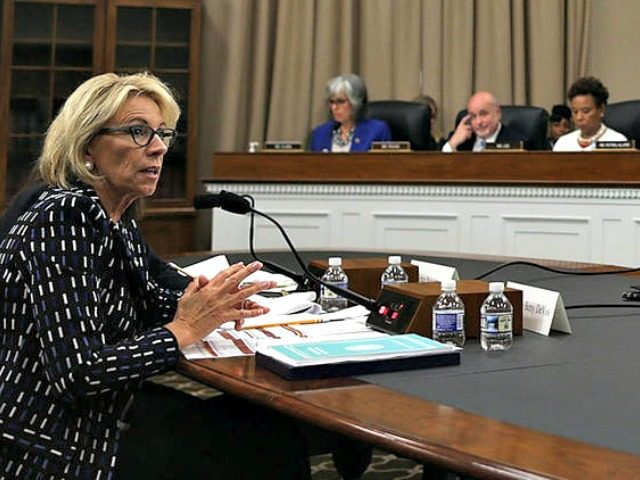Using #Questions4Betsy, some on the left mocked U.S. Education Secretary Betsy DeVos on Twitter leading up to her testimony Tuesday before a Senate Appropriations subcommittee regarding the Trump administration’s proposed education budget for 2018.
#Questions4Betsy what will you do when your plans to indoctrinate children blow up in your face? Back to your family pyramid schemes?
— Dr Alicia Beck (@AliciaBeck20) June 6, 2017
#Questions4Betsy: do you still believe we need guns in schools to protect students from grizzly bears? pic.twitter.com/4HXwUhsmLZ
— Generation Progress 🗳️ (@genprogress) June 6, 2017
In her opening statement to the Senate Appropriations subcommittee on Labor, Health and Human Services, and Education, DeVos – a strong proponent of school choice – reiterated the president’s proposed 2018 budged would “reduce overall funding for Department programs by $9 billion, or 13 percent.”
#Questions4Betsy – How does it feel being even dumber that Ben Carson? pic.twitter.com/OK3xAKRMQo
— Liberal Resistance (@LiberalResist) June 6, 2017
If Peter has 5 apples, and Dave takes 2, how long ago was Dave forced to begin stealing because of your school lunch cuts? #Questions4Betsy
— Richard Jeter (@MilesToGo13) June 6, 2017
The secretary said decisions about the budget were made using five principles:
First, our request would devote significant resources toward giving every student an equal opportunity for a great education. It emphasizes giving parents more power and students more opportunities.
Second, the Administration’s request recognizes the importance of maintaining strong support for public schools through longstanding State formula grant programs focused on meeting the educational needs of the nation’s most vulnerable students, including poor and minority students and students with disabilities.
Third, our request maintains funding for key competitive grant programs that support innovation and build evidence of what works in education. This also means strong support for the research and data collection activities of the Department.
Fourth, our request reduces the complexity of funding for college while prioritizing efforts to help make a college education accessible for low-income students through programs like Year-Round Pell.
And fifth, consistent with our commitment to improve the efficiency of the Federal government, our request would eliminate or phase-out 22 programs that are duplicative, ineffective, or are better supported through State, local or philanthropic efforts. All told, taxpayers will save $5.8 billion.
DeVos also returned, in her opening statement, to the story of a former East Hartford, Connecticut student – Michael Robert Biagioni – who spoke to the secretary about his experience in that school district prior to DeVos’s testimony before the House Appropriations subcommittee on May 24.
In an op-ed at the Hartford Courant Sunday, Biagioni – now a resident of Florida and an honor student at Valencia College – described the vitriol he has encountered in his Facebook account since the secretary used his story as an example of the failings of a public school.
“Respectfully, I responded to angry teachers who told me I was wrong for sharing my story,” Biagioni writes. “These teachers are part of a union that rallied against the secretary for using my experience as an example for what is wrong with the current educational system.”
He continued about his experience in East Hartford:
I was an average student until I reached my middle-school years in East Hartford, when I began to experience constant teasing and bullying. I always backed down from fights because of my faith-based belief that I should “turn the other cheek” (Luke 6:29). This is likely what led to continuous targeting to the point where I avoided entering the school’s bathroom after I witnessed someone who bullied me being forced into the trash by four other students. I failed most of my tests, but my teachers passed me to the next grade anyway. They gave me a diploma, but I hadn’t learned much.
DeVos recounted that Biagioni described the East Hartford public school experience as “nothing more than adult day care…a dangerous daycare.”
Biagioni provides the following statistics in his op-ed:
Here are the facts of my high school today, which elected officials and special interests groups in Connecticut are now defending after DeVos told my story. According to the Connecticut State Department of Education’s report for the 2015-2016 school year, the District Performance Index average for East Hartford in English language arts is 56.4, math is 48.3 and science is 47.7. Connecticut’s target for each of these three proficiencies is 75. The district’s average of chronic absenteeism is 12.9 percent (the state average is 9.6 percent), and its suspension/expulsion rate is 12.5 percent (state average is 7 percent). According to the same report, only 58 percent of students from East Hartford are entering college (state average is 71.9 percent). Of those who go to college, only 76 percent continue to a second year (state average is 88.3 percent).
“In a nutshell, the East Hartford district consistently performs below the state average in student proficiencies while disciplining students above the state rate,” he asserts. “Taking all of this into consideration, how is it that the graduation rate for East Hartford High School is 94 percent?”
In her testimony, DeVos defended Biagioni as well, quoting from his op-ed:
[R]ather than automatically getting into a defensive crouch at perceived slights, let’s admit that these serious and real problems exist, and that there’s a lot of work to do. Let’s give the kids and families who feel trapped the opportunity to find something better.
“My relaying of Michael’s story is not a blanket indictment of public schools, of Connecticut schools or even of East Hartford High School,” the secretary told members of the subcommittee. “What Michael’s story is, is the real life situation far too many of our students face: they are trapped in an education system, that for whatever reason, is not serving them, and they have no other choices.”

COMMENTS
Please let us know if you're having issues with commenting.